
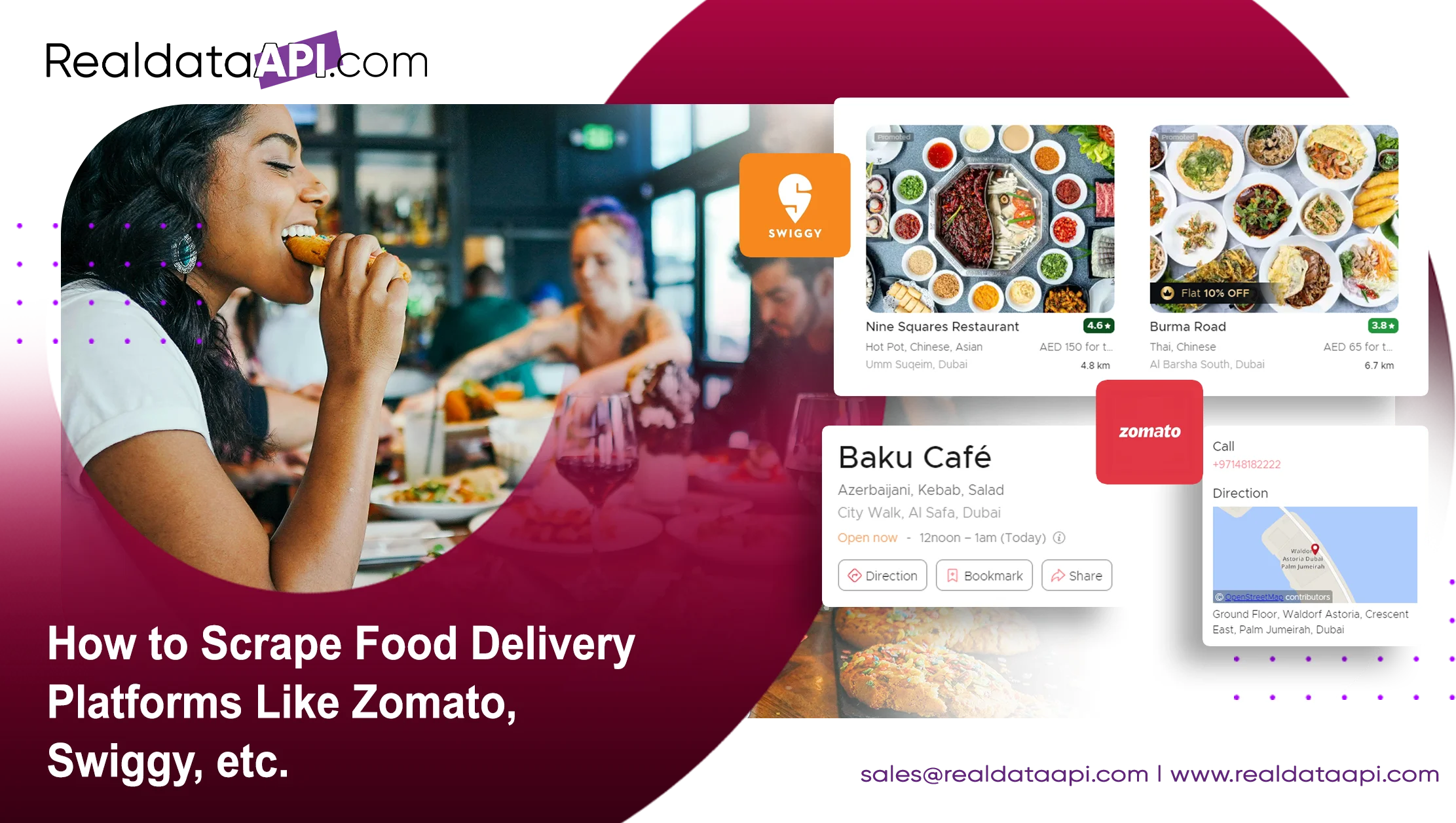
Introduction
In today’s fast-paced digital landscape, food delivery platforms such as Zomato, Swiggy, Uber Eats, and others play a crucial role in connecting consumers with their favorite restaurants. For businesses, developers, and data enthusiasts, scraping data from these platforms can unlock valuable insights into market trends, customer preferences, and restaurant performance. This blog will explore how to scrape food delivery platforms effectively, focusing on the tools and techniques necessary for success.
Why Scrape Food Delivery Data?
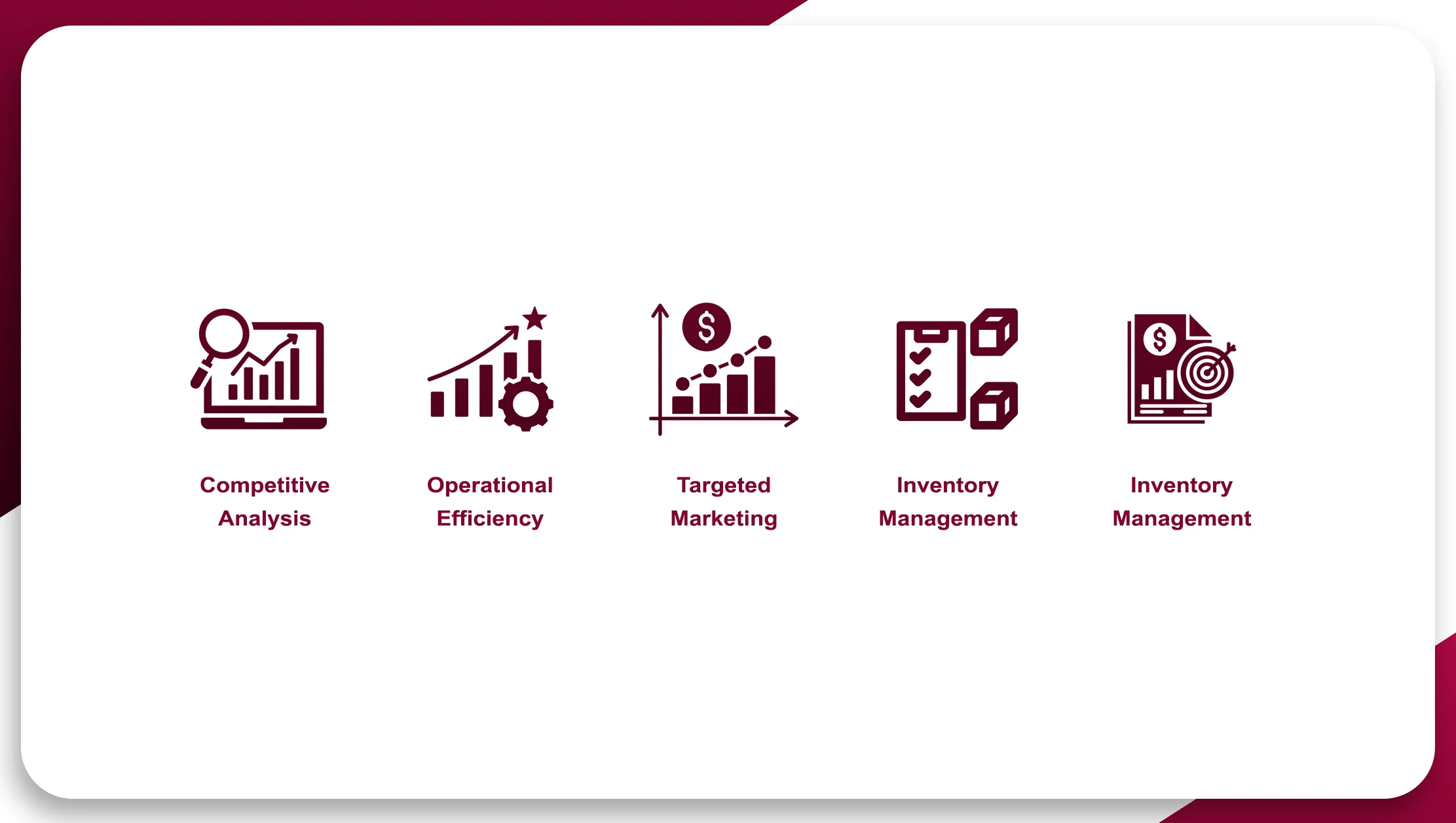
Web scraping food delivery data from platforms like Zomato, Swiggy, Uber Eats, FoodPanda, Grubhub, and many more will help the businesses stay updated with critical insights that would help them improve their operations and competitive positioning in this fast-changing food service industry. Here are a number of compelling reasons for undertaking this data scraping initiative.
Market Insights: By gathering data from these platforms, businesses can analyze trends in customer preferences, popular cuisines, and peak ordering times. Understanding what menu items are trending can help restaurants adapt their offerings to meet consumer demand, thereby increasing sales.
Competitive Analysis: Scraping data from food delivery platforms allows businesses to monitor competitor pricing, promotional offers, and customer reviews. This information is vital for making informed decisions about menu pricing, marketing strategies, and customer engagement. For instance, knowing how competitors like Domino's Pizza or DoorDash are performing can inform your business strategy and help you identify areas for improvement.
Operational Efficiency: Access to real-time data on delivery times, customer feedback, and order volumes enables restaurants to optimize their operations. For example, analyzing data from Deliveroo can help a restaurant adjust staffing levels during peak hours, improving service quality and customer satisfaction.
Targeted Marketing: Data scraping can facilitate targeted marketing campaigns. By understanding demographic data and ordering habits, restaurants can tailor their marketing efforts to specific customer segments, increasing the effectiveness of promotions and driving sales.
Inventory Management: Finally, data collected from food delivery platforms can assist in better inventory management. By tracking popular items and their sales velocity, restaurants can reduce waste and optimize stock levels, leading to improved profitability.
Web scraping food delivery app helps businesses extract data from various platforms like Zomato, Swiggy, Uber Eats, Grubhub, Postmates and many others, providing rich insights to support informed, data-driven decisions for better performance and growth.
Essential Tools for Web Scraping

To scrape data effectively, you need the right tools. Here are some commonly used libraries and frameworks:
BeautifulSoup: Ideal for parsing HTML and extracting data.
Scrapy: A powerful and flexible framework for large-scale web scraping.
Selenium: Useful for scraping dynamic websites that use JavaScript.
Requests: A simple library for making HTTP requests.
Steps to Scrape Food Delivery Platforms
1. Understand the Website Structure
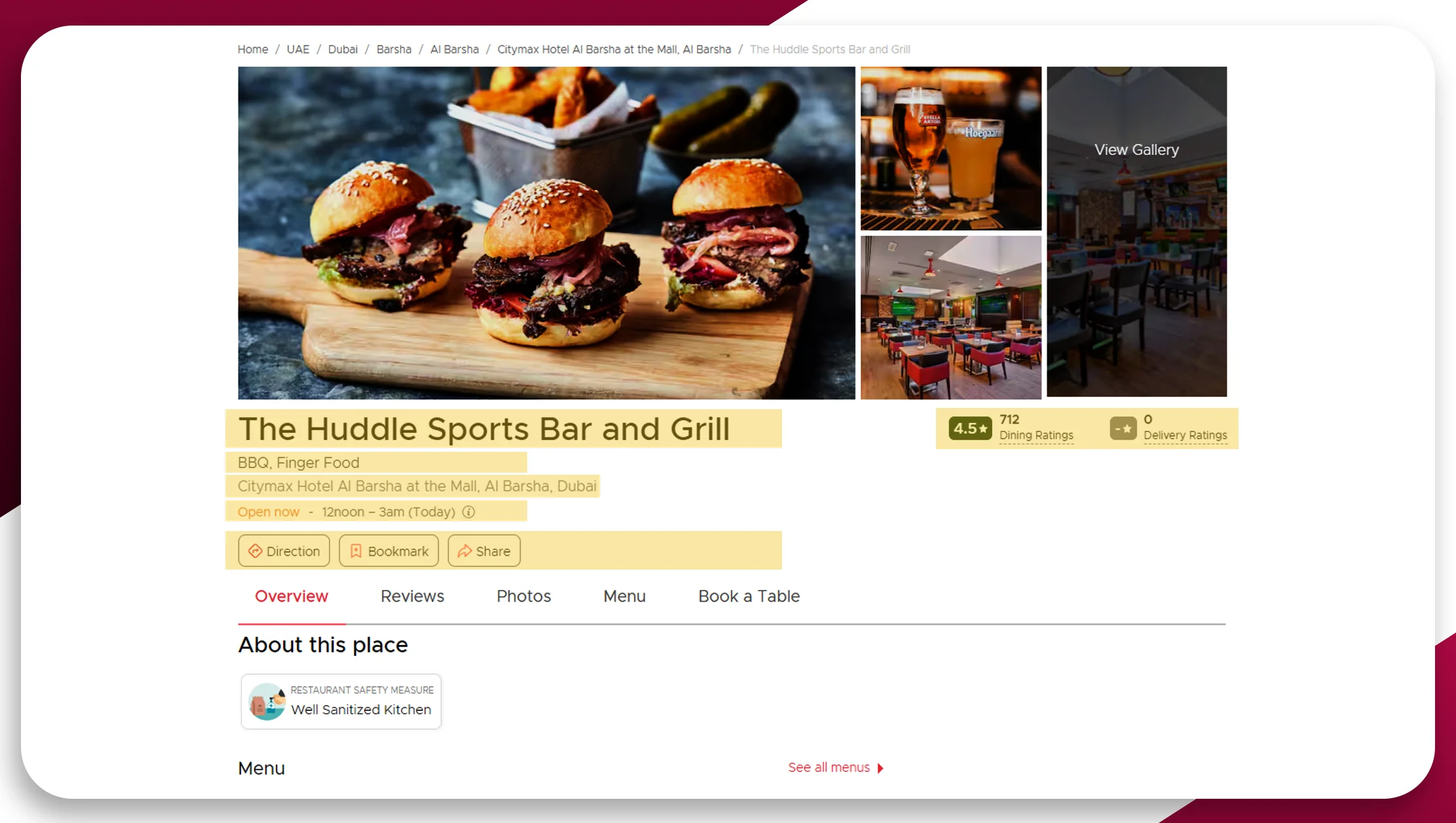
Before you start scraping, inspect the website's HTML structure. Use browser developer tools to identify the elements containing the needed data, such as restaurant names, menu items, prices, and customer reviews.
2. Set Up Your Environment
Install the necessary libraries. You can do this using pip:
pip install requests beautifulsoup4 scrapy selenium
3. Write the Scraping Code
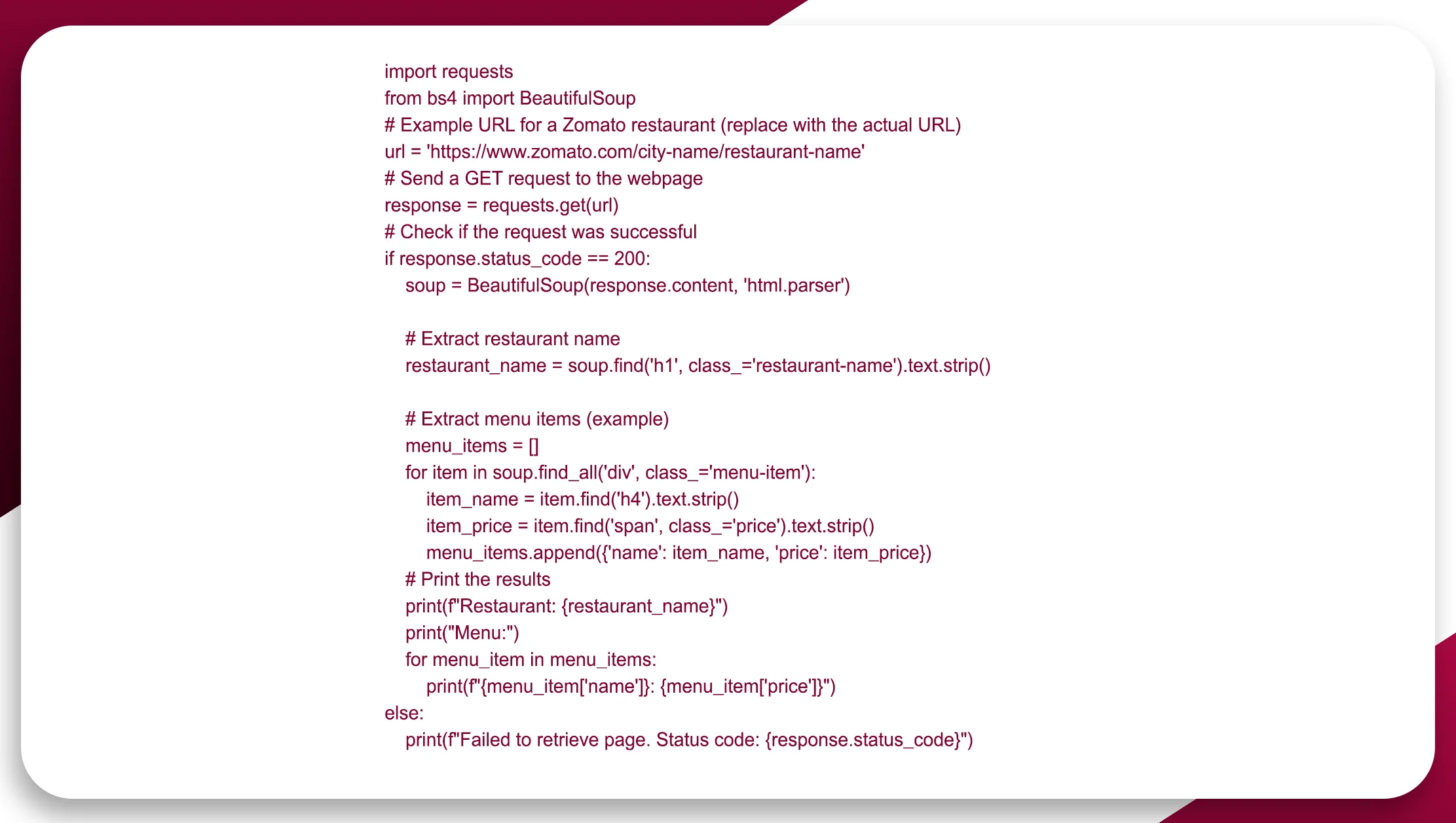
Here’s an example of how to scrape data from Zomato using BeautifulSoup and requests:
4. Handle Pagination
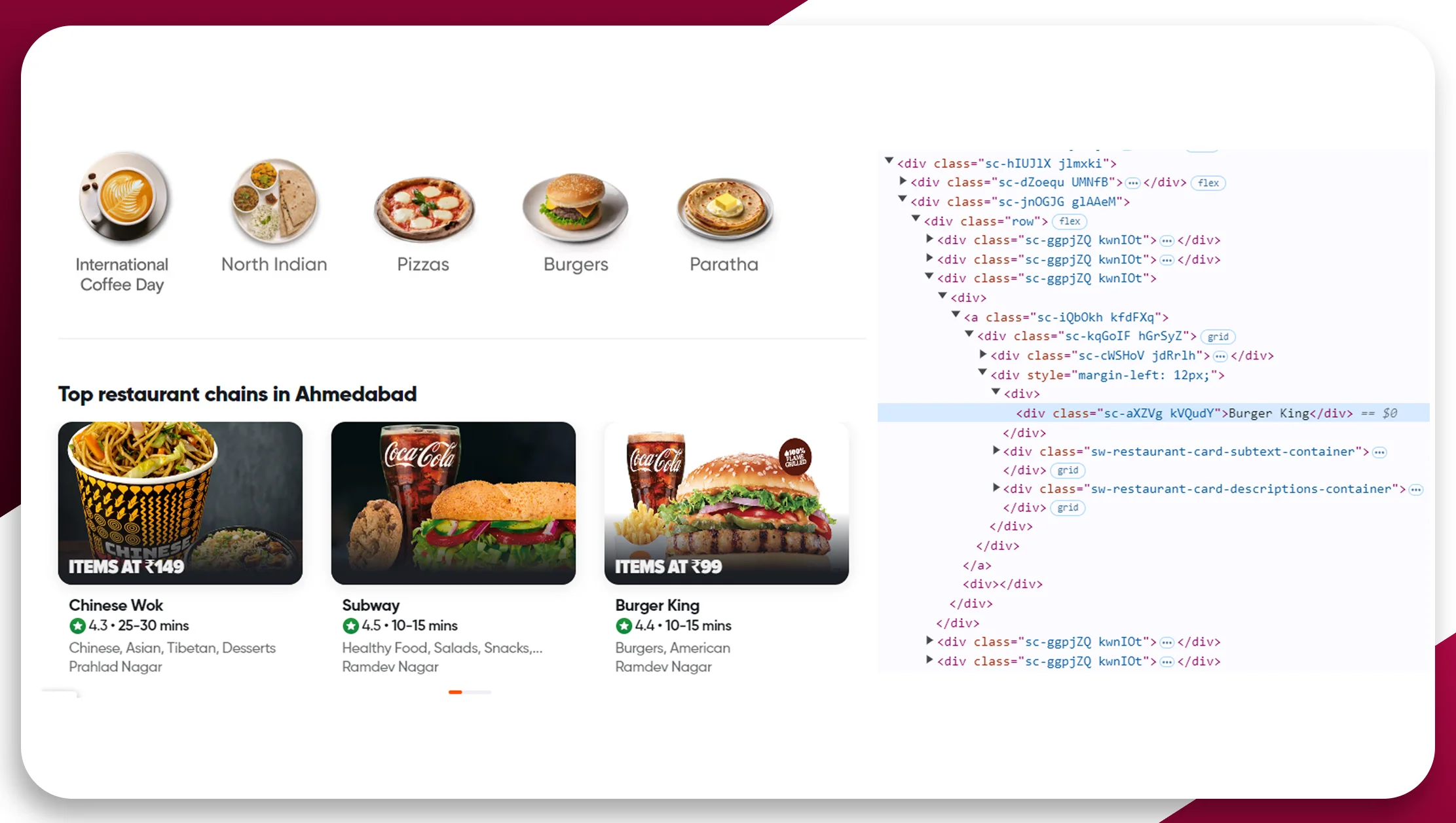
Most food delivery platforms display data across multiple pages. Make sure your code can navigate through Pagination to scrape all relevant data.
5. Explore API Options
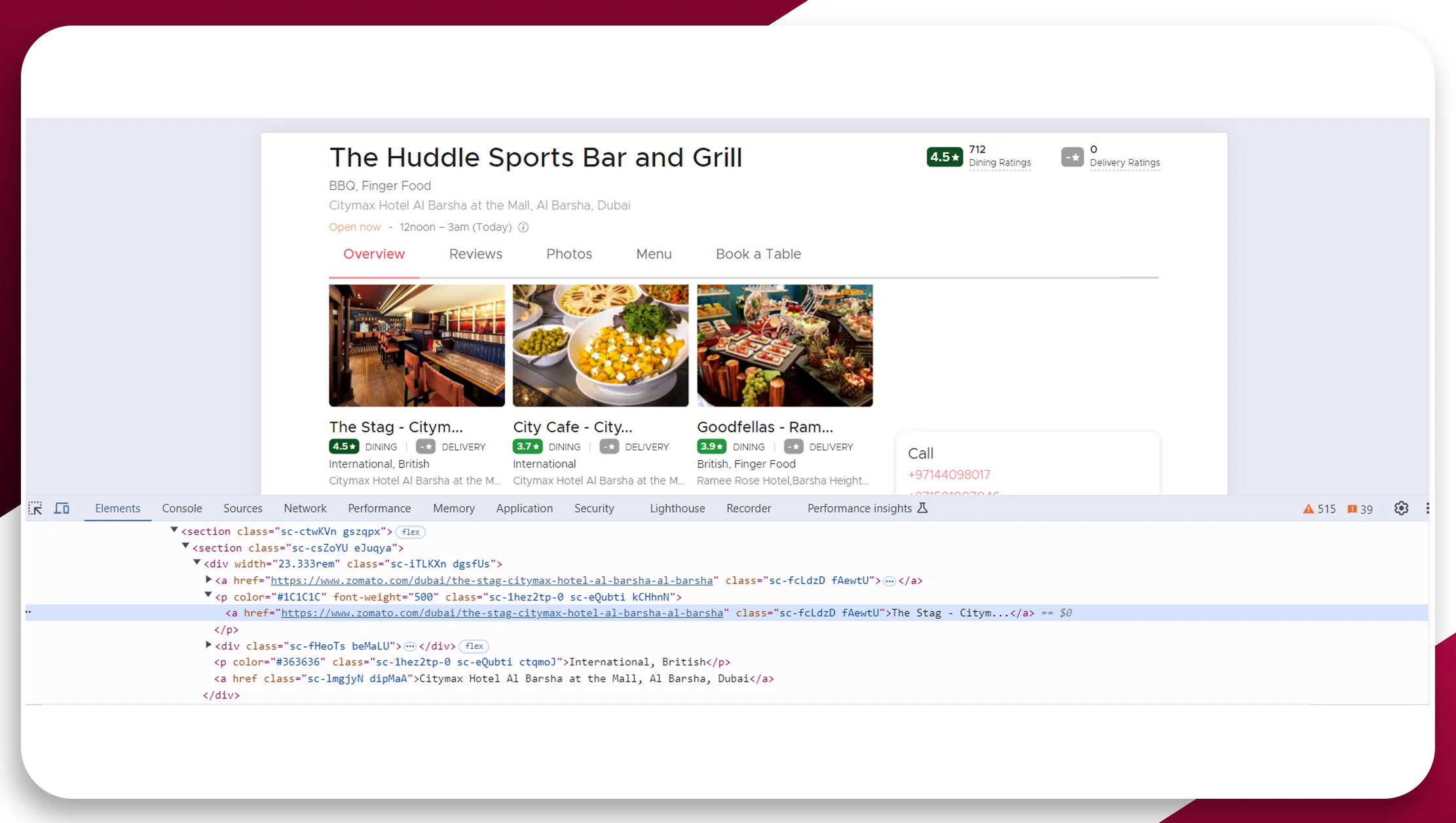
Some food delivery platforms offer APIs for easier data access. Consider using these APIs for structured data retrieval instead of scraping HTML if available.
6. Adhere to Legal Guidelines
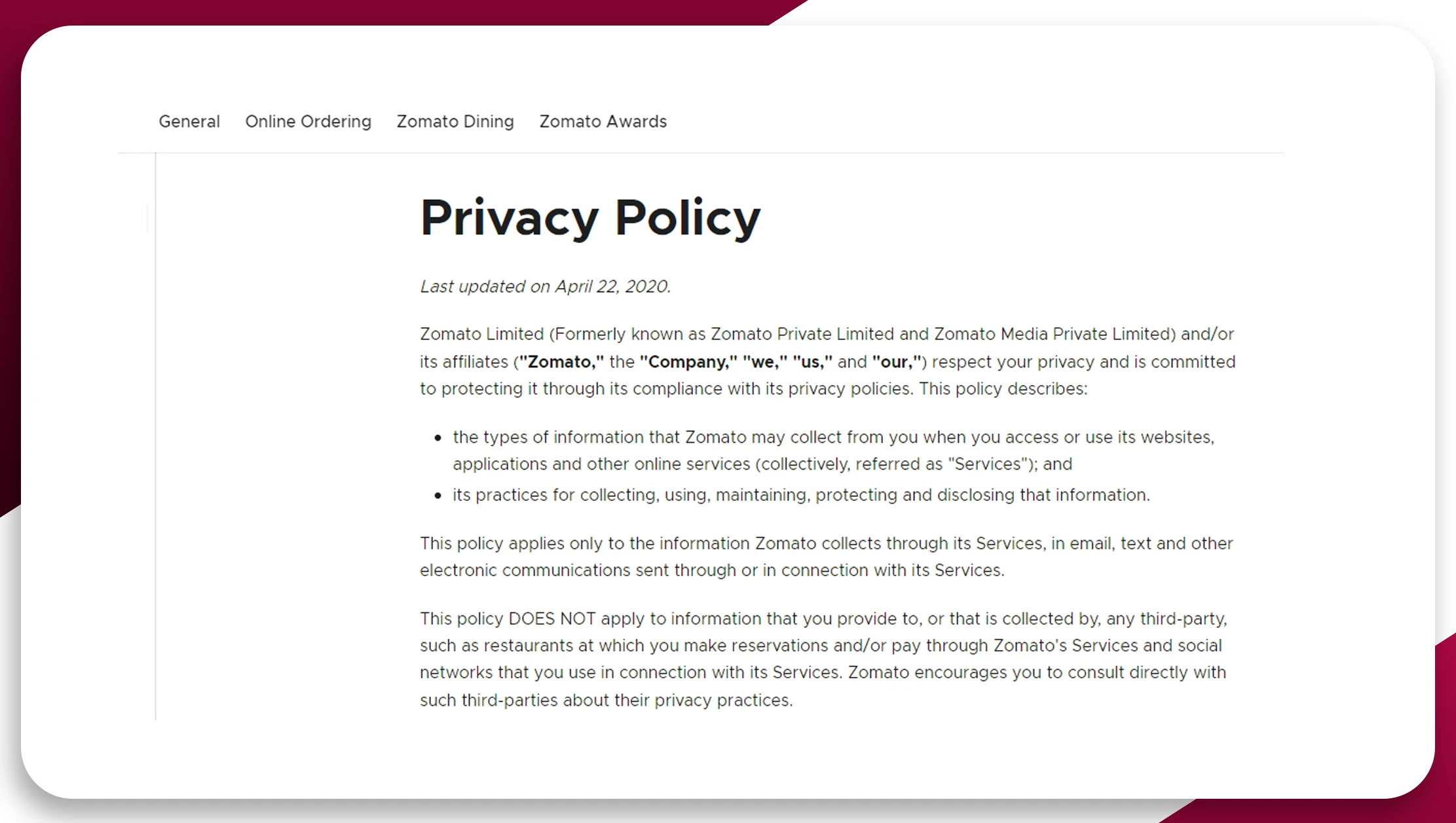
Always review each platform's terms of service before scraping. Ensure compliance with their rules to avoid any legal issues.
Scraping Individual Food Delivery Platforms
Zomato Food Data Scraping

Zomato operates as one of the renowned food delivery platforms around the world. Scraping information from Zomato will make provision for restaurant listings, menu items, user reviews, and ratings. Access to detailed restaurant profiles could be availed to analyze the food preferences and pricing trends of different regions. Using a Zomato API for restaurant data scraping, if available, can provide structured data and may make the extraction process easy.
Swiggy Food Data Scraping

Swiggy is yet another popular food delivery platform in India. By scraping Swiggy, you will get updates about local restaurants, their menus, discounts, and customer reviews. The dynamic content of the platform requires the use of tools like Selenium for accurate data capture. With Swiggy data scraping and the Swiggy Data Scraping API for strategic advantage and data-driven decision-making, businesses can identify regional trends and optimize their offerings based on popular dishes.
Uber Eats Food Data Scraping

Uber Eats has a wide network of restaurants. Scraping Uber Eats will provide data on the location of restaurants, menu items, and pricing strategies. Analyzing this data helps businesses in better positioning in the competitive food delivery market. This can be further enhanced using the Scrape Uber Eats API for enhanced restaurant insights to extract data in a structured manner and provide access to restaurant information.
Grubhub Food Data Scraping

Grubhub is one of the biggest food delivery services in the United States. Scraping Grubhub provides key insights into restaurant offerings, delivery times, and customer feedback. The information will be important to understand consumer behavior and enhance the delivery of services. This data, combined with the Grubhub Food Delivery Scraping API, allows businesses to enhance their marketing strategies and make their services meet the needs of their customers.
Deliveroo Food Data Scraping

Deliveroo is a premium restaurant food delivery service, operating in several countries. Data scraping of Deliveroo shall help the business in gauging competitor offerings and price. The data so collected may be used to craft focused marketing campaigns and understand customer preferences geographically. A Deliveroo Data Scraper will help the business in intelligently extracting valued data from the portal for insights and further competitive positioning of its service.
FoodPanda Food Data Scraping

FoodPanda is popular in Asia and provides a large choice of restaurants. With FoodPanda scraping, one can extract data on restaurant menus, customer ratings, and available discounts. This could provide information to businesses on market trends and customer preferences so that they can refine their offerings of products. Utilizing the Foodpanda API for datasets and applications can further enhance data extraction processes and provide structured insights to support strategic decision-making.
Domino’s Pizza Data Scraping

Scraping in Domino's Pizza as the leading pizza delivery chain provides clear insights into regional differences in their menus. Pricing strategies for a variety of pizza offerings can be analyzed along with consumer preferences to enable Dominos to optimize offerings and promotional activity. With Domino's Food Data Scraping, gathering valued data is possible that improves decision-making and leads to increased customer satisfaction.
Just Eat Takeaway Food Data Scraping

Just Eat Takeaway is a leading marketplace in Europe. Scraping this platform will provide knowledge about restaurant listings, customer reviews, and meal options. This information can help businesses in understanding the consumer preference trend and accordingly price their menu for better profits. In this way, Just Eat Food Data Scraping can enhance the process of data gathering to aid strategic decisions and improvement of overall services.
DoorDash Food Data Scraping

With a solid reputation for its vast restaurants, DoorDash offers opportunities in data scraping: restaurant menu details, customer ratings, and estimated delivery times can all be extracted. This type of web data is crucial for devising effective local competition intelligence strategies and optimizing service delivery plans. This DoorDash food delivery data scraping API automatically scrapes the required information with high accuracy, enabling informed business decisions and increasing operation efficiency.
Postmates Food Data Scraping

Postmates delivers food from restaurants and stores. Scraping Postmates will give insights into menu items, their prices, and user feedback. The information will help the business in changing marketing strategies to please customers by adding popular items. The Postmates Food Delivery Scraping API will increase the efficiency of data extraction for a business to gain valuable insights that inform its decision-making and optimize service offerings.
iFood Food Data Scraping

iFood is one of the leading food delivery platforms in Brazil. Scraping iFood allows businesses to gather crucial data on restaurants in the locality, their respective offerings, and customer reviews. Grasping regional preferences, it helps the business mold its services and menu offerings toward customers' demands. With the implementation of iFood Food Data Scraping, data intake becomes efficient and insights are drawn out that support strategic decisions and enhance customer satisfaction.
Wolt Food Data Scraping

Wolt is present in many countries, and its main purpose is to deliver food from local restaurants. Scraping Wolt may provide insights into the performance of restaurants, customer preferences, and trending dishes in different markets. Such information can help businesses enhance their marketing strategies and improve the services offered. By applying Wolt Delivery Food Data Scraping, one can efficiently extract data that will be helpful for businesses to adjust to consumer trends and enhance their competitive advantage.
Talabat Food Data Scraping

Talabat is one of the trendiest food delivery services in the Middle East. By applying Talabat scraping, information about restaurant menus, price lists, and user ratings can be obtained. Analysis will give insight into local trends, consumer preferences, and enable organizations to stay competitive. By putting Talabat Food Data Scraping into practice, all data collection will be performed effortlessly, and businesses will easily refine their offerings and adjust their strategic plans to meet customer requirements.
Delivery.com Food Data Scraping

Delivery.com offers a number of delivery options, including food from local restaurants. Scraping this platform lets you get data on restaurant offerings, customer ratings, and delivery times. This information can be used by businesses to fine-tune their marketing strategies and improve service delivery. Businesses can use tools to scrape Delivery.com food delivery data, which then helps them gather insights that will drive better decision-making and optimize their services to meet customers' needs.
Important Use Cases
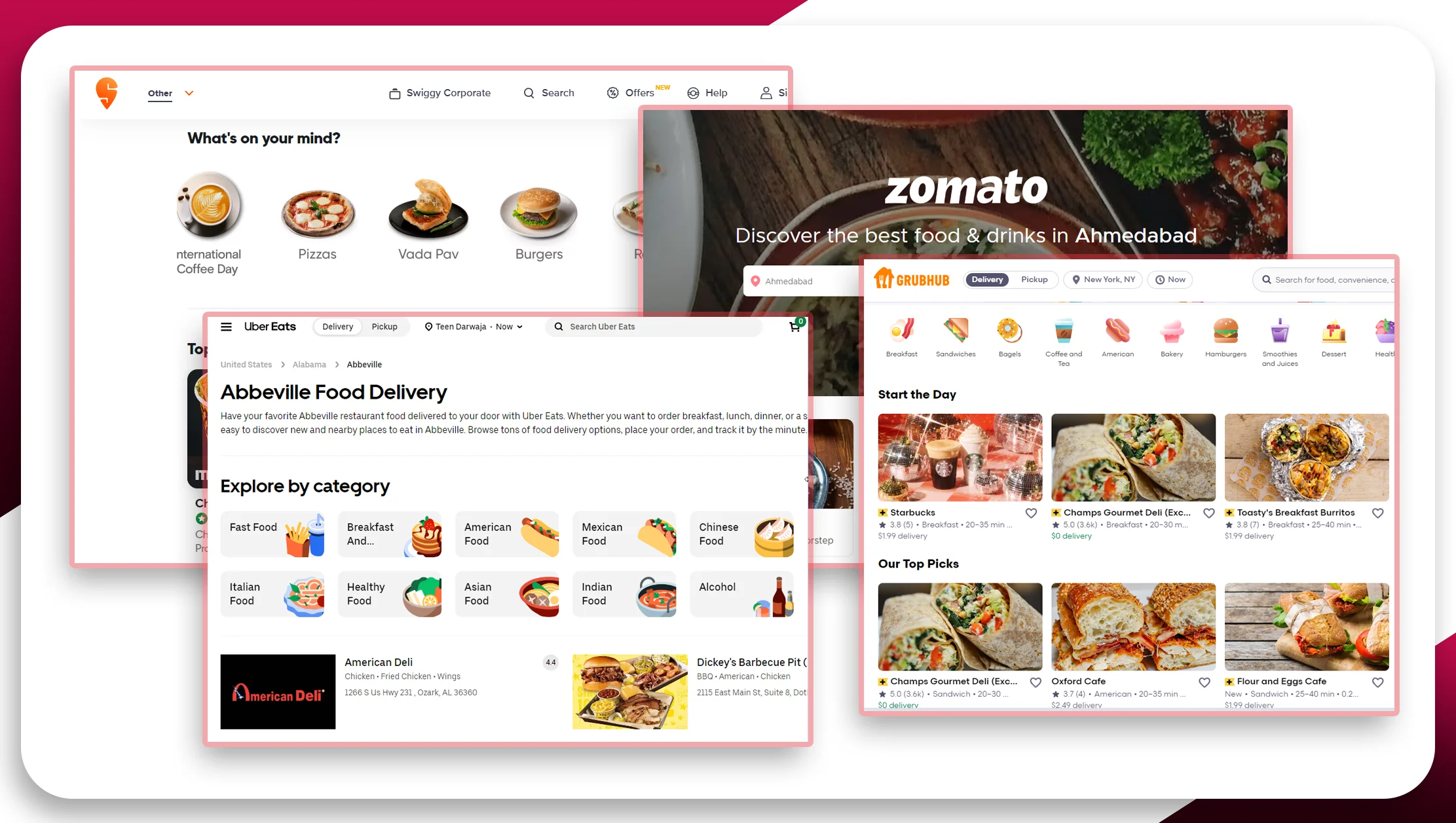
Scraping data from food delivery platforms like Zomato, Swiggy, Uber Eats, Grubhub, and others opens up a plethora of opportunities for various stakeholders in the food service industry. Here are some important use cases that highlight the significance of this data scraping activity:
Menu Optimization
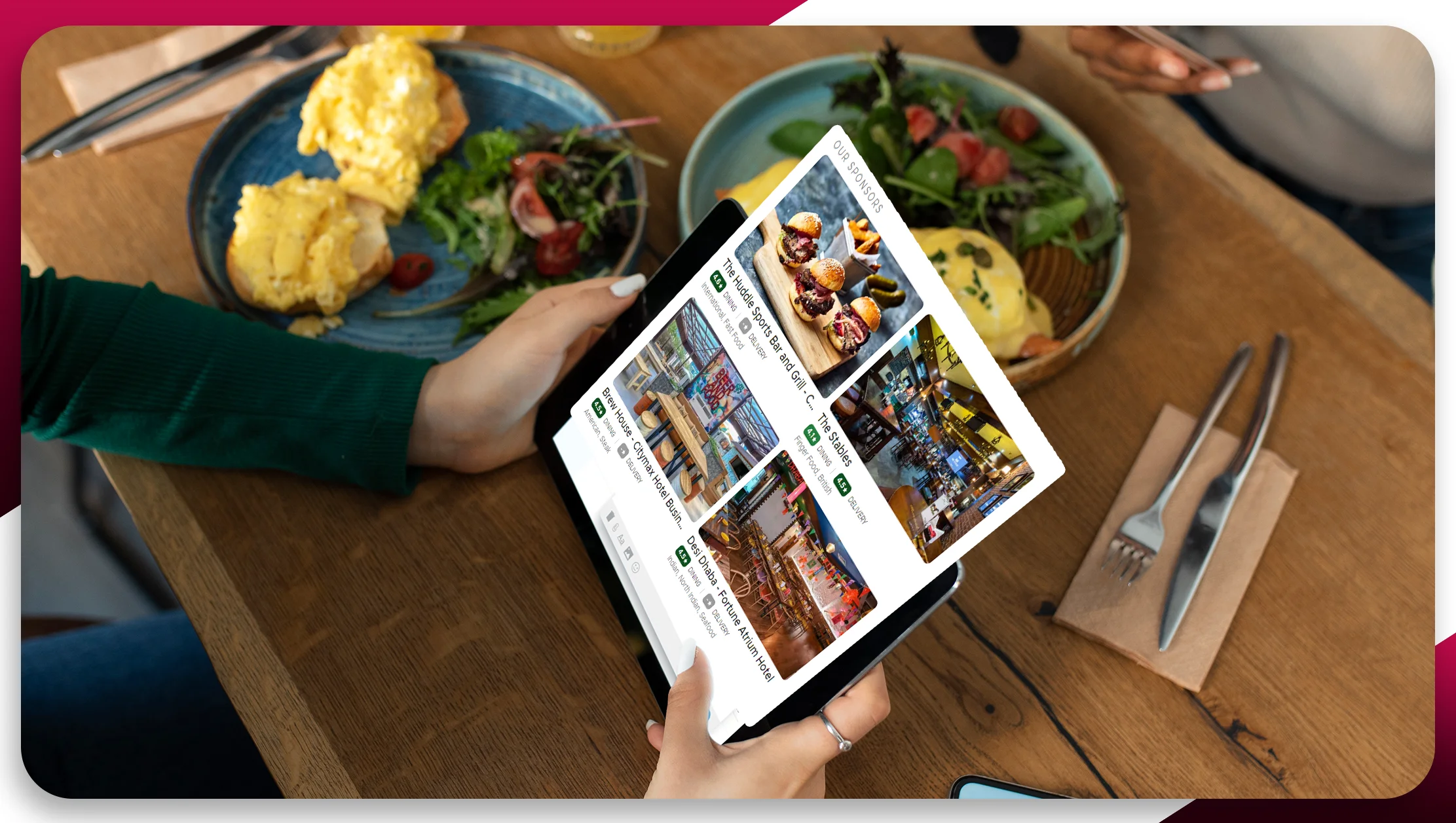
Restaurants can analyze data on popular dishes from various platforms to identify trends and customer preferences. For example, scraping Zomato and Swiggy can reveal which items are frequently ordered in specific regions, allowing businesses to tailor their menus accordingly, introduce new offerings, or eliminate underperforming dishes.
Pricing Strategies

Understanding competitor pricing is crucial in the food industry. By scraping data from platforms like Uber Eats and FoodPanda, restaurants can monitor how their prices compare to competitors. This enables them to adjust their pricing strategies to remain competitive while maximizing profit margins.
Location-Based Marketing
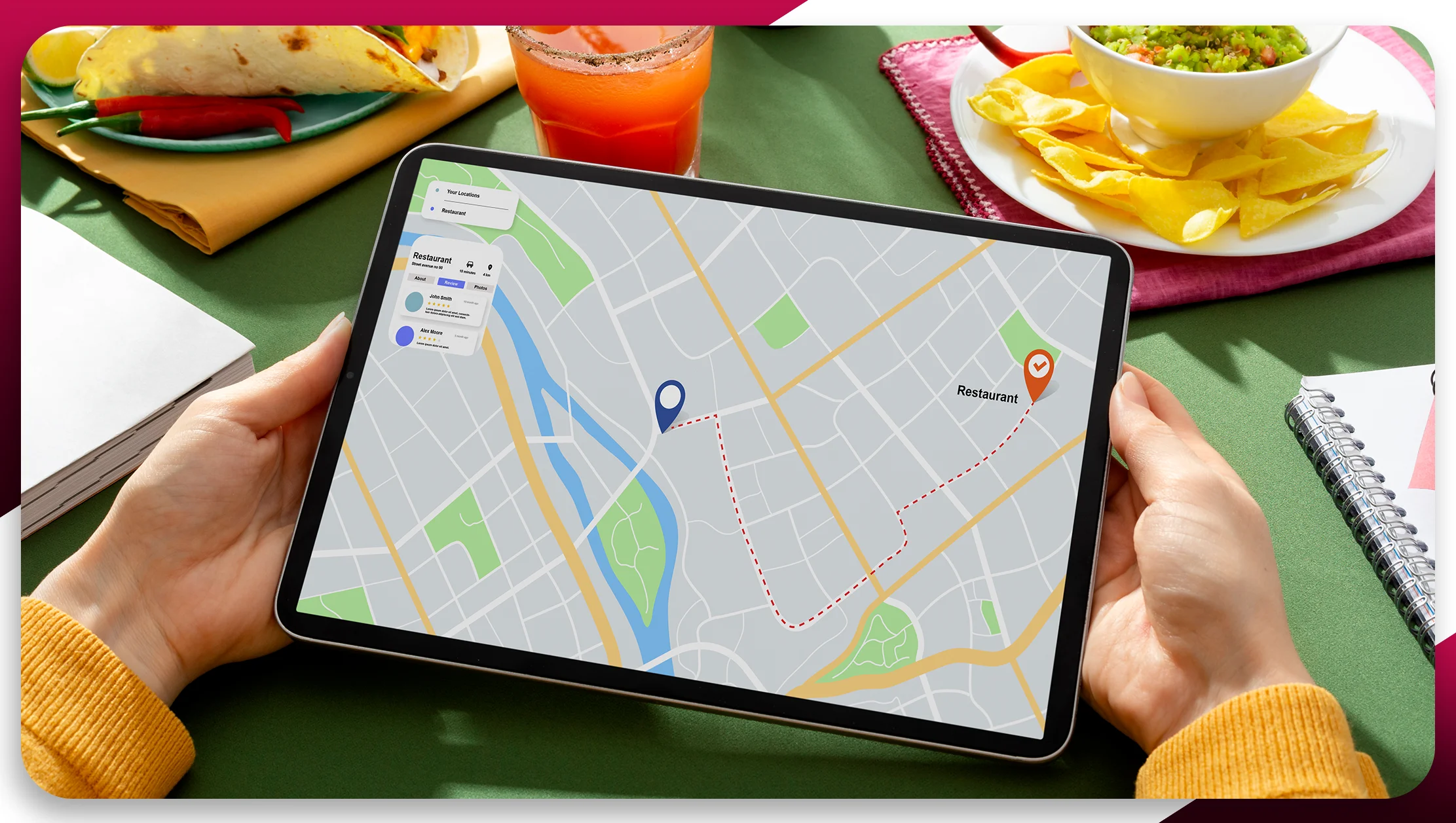
Data scraping can provide insights into customer demographics and preferences based on geographic locations. This information allows restaurants to create targeted marketing campaigns that resonate with local customers, enhancing engagement and driving foot traffic. For example, knowing that certain neighborhoods favor specific cuisines can inform advertising strategies.
Customer Sentiment Analysis
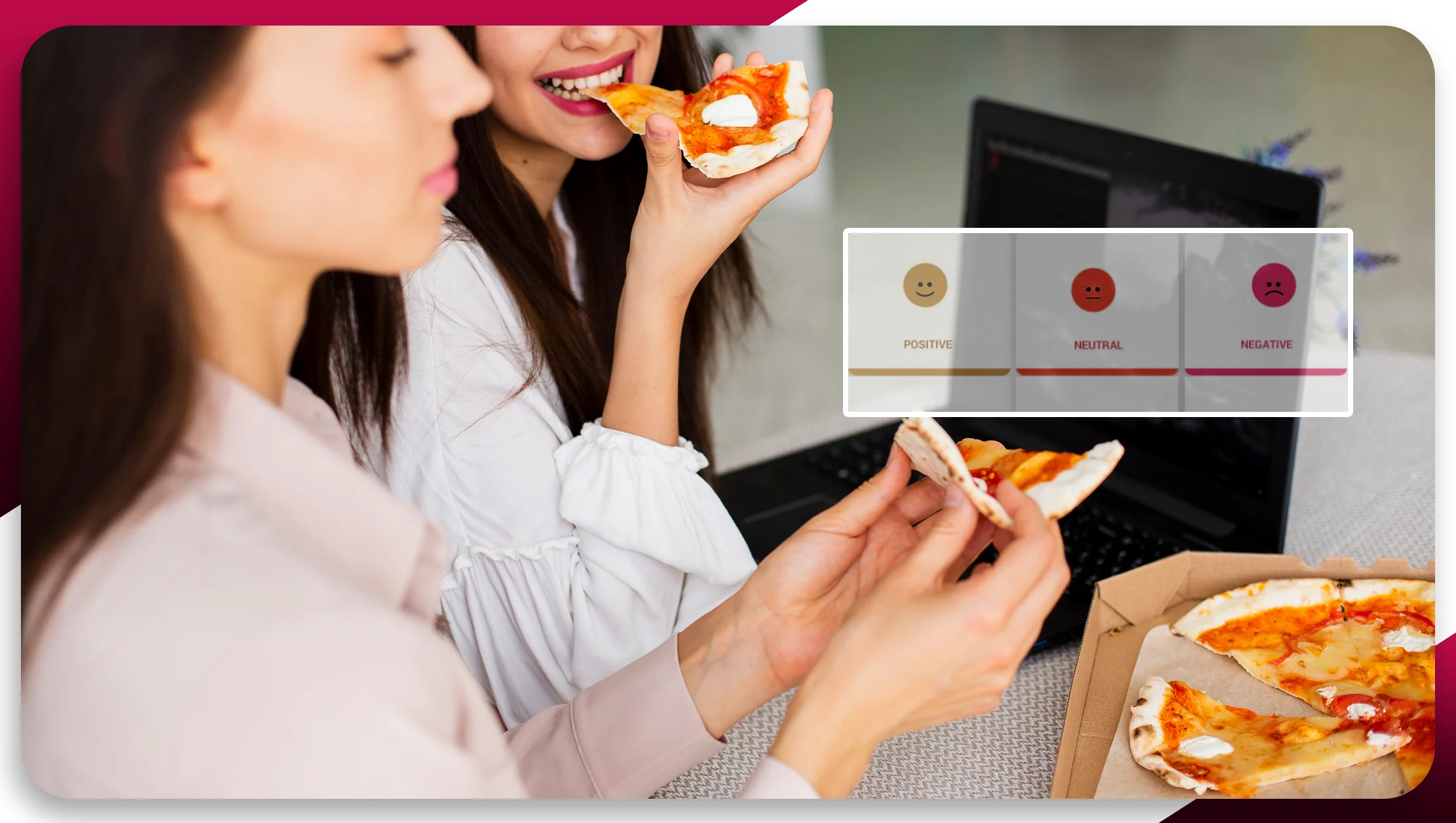
Scraping reviews and ratings from platforms like Grubhub and Zomato can help businesses gauge customer satisfaction and identify areas for improvement. Analyzing feedback can inform operational changes, menu updates, and customer service enhancements.
Inventory Management
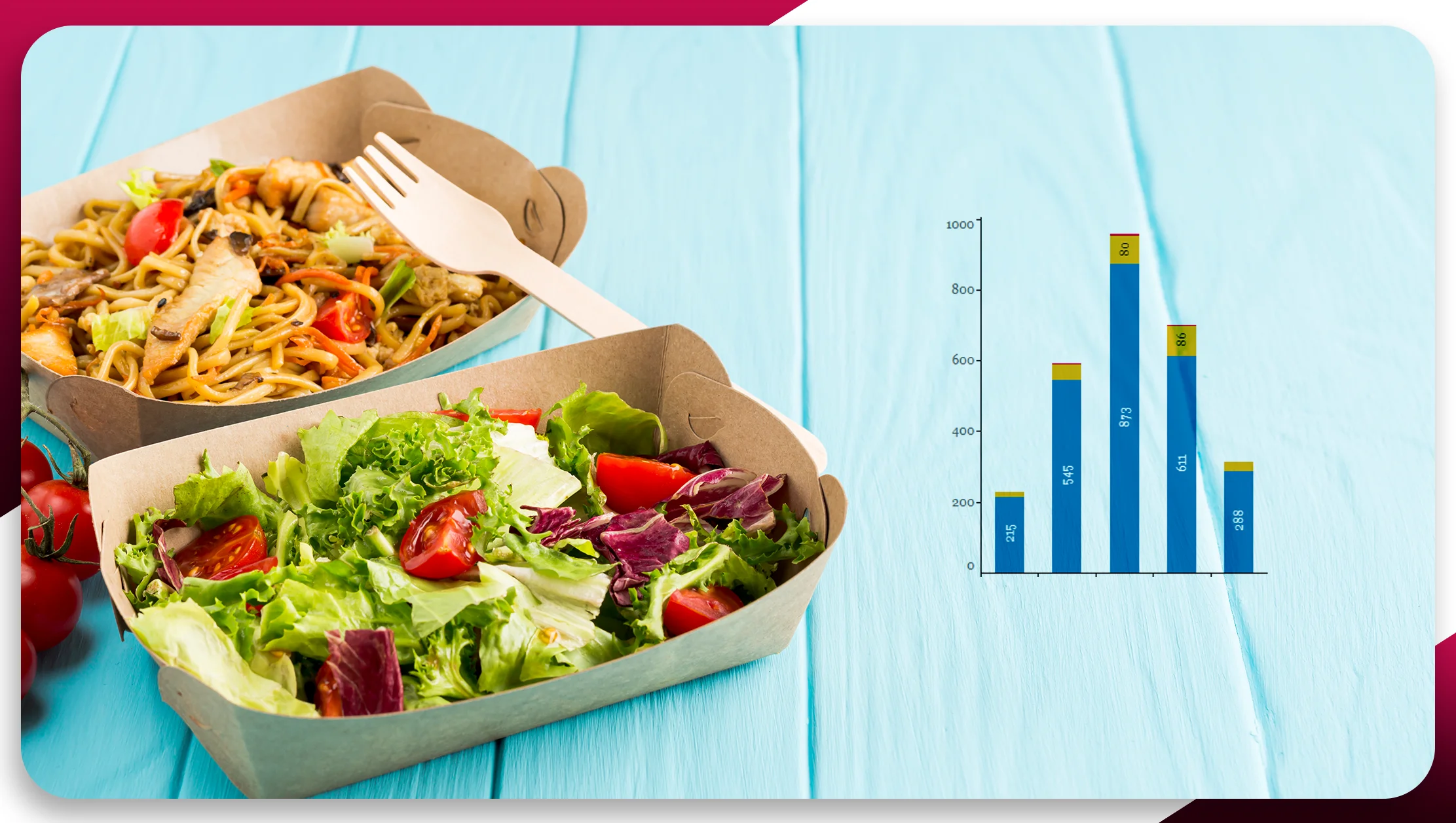
By tracking sales data and popular items through scraping, restaurants can optimize inventory levels, reducing waste and improving efficiency. Understanding which dishes sell quickly allows for better stock management and cost control.
In summary, the use cases for food delivery platform scraping are diverse and impactful. By leveraging the insights gained from this data, businesses can make informed decisions that enhance operations, improve customer satisfaction, and drive growth.
Conclusion
Scraping food delivery platforms like Zomato, Swiggy, and others is a powerful way to gain insights into the food industry. By following the proper techniques and using practical tools, you can gather valuable data through food data scraping that enhances business strategies and user experiences. Remember to scrape responsibly, adhering to all legal guidelines, to ensure a successful and ethical data collection process.
With the growing reliance on data-driven decisions, mastering food delivery data scraping can set you apart in this competitive landscape. By employing effective strategies for web scraping food delivery data, businesses can uncover trends, optimize menu offerings, and improve customer satisfaction.
At Real Data API, we offer tailored solutions to help you navigate the complexities of data scraping effectively. Start scraping today and unlock the potential of food delivery data to drive your success!












